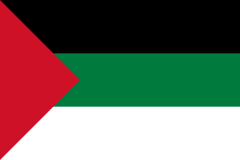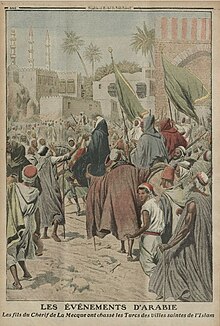Hussein bin Ali, King of Hejaz
His relationship with the Ottoman government deteriorated after the Committee of Union and Progress took power, particularly because of their policies of Turkification and persecution of ethnic minorities, including Arabs.He also participated in numerous expeditions to the Najd and the eastern regions of Hejaz to meet the Arab tribes, over whom the Sharifate of Mecca then exerted a loose form of control.During his travels, he also gained a thorough knowledge of the desert's flora and fauna and composed poems in humayni verse, a type of vernacular poetry (malhun) of the Bedouins.[30] He remained there for 15 years, until 1908, mainly focusing on raising his children, learning the politics of the Sublime Porte—where he aligned with the conservative faction—and hoping to return home.[30] Following the removal of his predecessor in October and the sudden death of his successor shortly thereafter, Hussein was appointed grand sharif by official decree of the sultan Abdul Hamid II in November 1908.[37] In 1911, Hussein became involved in an Ottoman campaign in 'Asir; the Young Turks requested his support to fight Muhammad ibn Ali al-Idrisi, who had recently revolted there and proclaimed the Idrisid Emirate.[54][55] All of these points led to a violent rupture between Arab elites and the Ottoman political class,[56] and are reflected in Hussein's later proclamation of independence, where he presented his struggle as a religious and anti-colonial one.[42][5][57] Twenty days after the start of the Armenian genocide in the Ottoman Empire, Hussein bin Ali's son, Faisal, met with the leaders of the revolutionary organization Al-Fatat in Damascus.[56] Following deliberations at Ta'if between Hussein and his sons in June 1915, during which Faisal counselled caution, Ali argued against rebellion and Abdullah advocated action[63] and encouraged his father to enter into correspondence with Sir Henry McMahon; over the period 14 July 1915 to 10 March 1916, a total of ten letters, five from each side, were exchanged between Sir Henry McMahon and Sherif Hussein.[56] High Commissioner McMahon accepted and assured him that his assistance would be rewarded by an Arab empire encompassing the entire span between Egypt and Persia, with the exception of British possessions and interests in Kuwait, Aden, and the Syrian coast.[71] The revolt proper began on 10 June 1916, when Hussein proclaimed the independence of the Kingdom of Hejaz and ordered his supporters to attack the Ottoman garrison in Mecca.[73] Also on 10 June, another of Hussein's sons, the Emir Abdullah, attacked Ta'if, a hill station near Mecca, which after an initial repulse settled down into a siege.[54] During this battle, the Ottomans killed and deported the civilian Arabic population of Medina into the Syrian desert, an event hidden by the pretense of doing "Seferberlik", or mobilization.[75][76] On 30 October 1916, Emir Abdullah called a meeting of majlis where he read a letter in which "Husayn ibn Ali was recognized as sovereign of the Arab nation.[71] This lack of artillery and high mobility ; since most of the troops were mounted Bedouins, pushed them to use guerilla tactics in the desert ; for example by severing Ottoman supplies with the bombings of specific sections of the Hejaz railway.[71] During the Battle of Megiddo, in September 1918, Hussein's troops led by his son Faisal, joined the British forces and managed to utterly destroy the 4th, 7th and 8th Ottoman armies, and push into retreat the Yildirim Army Group, comprising the German Asian Corps and led at the time by Mustafa Kemal Atatürk, thus leaving the Palestinian and Arabian front without defence, and finally breaking inside the Ottoman Empire.[71] After this, he engaged in the pursuit to Haritan, pursuing the remnants of the Yildirim Army Group and ultimately taking Aleppo on the 25 of October 1918, thus ending the war on that front.[66] This only aggravated his conflict with Abdulaziz ibn Saud, which was already present because of their differences in religious beliefs and with whom he had fought before the First World War, siding with fellow anti-Saudis, the Ottomans in 1910.He also addressed the issue of stray dogs, attempted to ensure the security of the Hajj routes, and sought to combat the prevalent slave markets in the Hejaz region.In April 1918, as part of his conquest of the Syrian territories in which the Armenian genocide took place, he issued a decree to protect Armenians from persecution and allow them to settle in peace, in which he ordered :[89][90][91][92] "What is requested of you is to protect and to take good care of everyone from the Jacobite Armenian community living in your territories and frontiers and among your tribes; to help them in all of their affairs and defend them as you would defend yourselves, your properties and children, and provide everything they might need whether they are settled or moving from place to place, because they are the Protected People of the Muslims (Ahl Dimmat al-Muslimin) – about whom the Prophet Muhammad (may Allah grant him His blessings and peace) said: "Whosoever takes from them even a rope, I will be his adversary on the day of Judgment".[11][101] In January and February 1918, Hussein received the Hogarth Message and Bassett Letter in response to his requests for an explanation of the Balfour Declaration and Sykes-Picot Agreement respectively.[107] Other accounts, such as a Reuters dispatch, instead set the date as March 7, 1924, and describe Hussein bin Ali being elected as a caliph by Muslims from "Mesopotamia, Transjordan, and Hejaz".Those who wish to participate in this great endeavor should express their intentions to our representatives in Mecca.In the same perspective, he financially supported the members of the exiled Ottoman dynasty to prevent them from being ruined.[111] They believed that having a new influential caliph could risk reviving pan-Islamism, causing instability in French Muslim colonies in the event of a conflict, and potentially giving the Red Sea to the British.[115][116] Although the British had supported Hussein from the start of the Arab Revolt and the McMahon–Hussein Correspondence, they not only chose not to help him to repel the Saudi conquest of Hejaz, but even provided weapons to Ibn Saud,[115] which eventually took Mecca, Medina, and Jeddah.During this period, King Hussein is described as having taken over control that his son wielded, and therefore was sent to live in Aqaba (which was recently transferred from Hijazi to Transjordanian sovereignty by the British).[125] He received some visitors, such as Sheikh Fuad al-Khatib, Muhammad Jamil Bayham, who wanted to write his biography, or the Jordanian poet Mustafa Wahbi Tal, among others.[125] His two sons, Ali and Abdallah, attended the funeral and started making preparations and requesting the British for his repatriation, believing that he didn't have much time left to live and that they needed to be by his side.They feared that his death would not only stir resentment among Arabs towards the United Kingdom but also potentially strain their relationships with the Hashemite rulers, all of whom were allies in the Middle East.[86] This idea was kept and after a procession where 30,000 people took part,[132] he was buried in Jerusalem: inside the Arghūniyya, a building on the Haram esh-Sharif or "Temple Mount", in a walled enclosure decorated with white marble and carpets.
















Hussein bin Ali (disambiguation)King of the ArabsSharifian CaliphCustodian of the Two Holy MosquesKing of HejazAli bin HusseinSharif and Emir of MeccaAbdallah bin MuhammadCaliphAbdulmejid IIConstantinopleOttoman EmpireTransjordanNoble SanctuaryJerusalemBritish PalestineAdila KhanumAli of HejazAbdullah I of JordanFaisal I of IraqPrince ZeidBanu QatadahDynastyHashemite dynastySunni IslamKingdom of HejazSharifian ArmyArab RevoltBeliefsOnenessAngelsRevealed BooksProphetsDay of ResurrectionPredestinationPracticesProfession of FaithPrayerAlmsgivingFastingPilgrimageFoundationsSunnahHadithTafsir (exegesis)IjtihadAqidah (creed)Qisas al-Anbiya ("Stories of the Prophets")MathnawiFiqh (jurisprudence)Sharia (law)HistoryTimelineJahiliyyahMuhammadAhl al-BaytSahabahRashidunCaliphateImamateSpread of IslamSuccession to MuhammadCulturesocietyAcademicsAnimalsAssociation footballCalendarChildrenCircumcisionDemographicsDiasporaDenominationsEconomicsEducationEthicsExorcismFeminismFestivalsFinanceLiberalismMadrasaMoral teachingsMosqueMysticismPhilosophyPoetryPoliticsProselytizingScienceSexualitySlaveryConcubinageSocial welfareApostasyCriticismArabic languageOther religionsIslamismViolenceterrorismIslamophobiaJihadismSalafi jihadismDeobandi jihadismMilitary lawsGlossaryArabicromanizedBanu HashimGreat Arab RevoltKing of the HejazHe proclaimed himself Caliphabolition of the Ottoman CaliphateinvadedSaudisBritishFrenchZionistsWahhabisMehmed VIpan-ArabismYoung Turk RevolutionOttoman sultanAbdul Hamid IICommittee of Union and Progress

